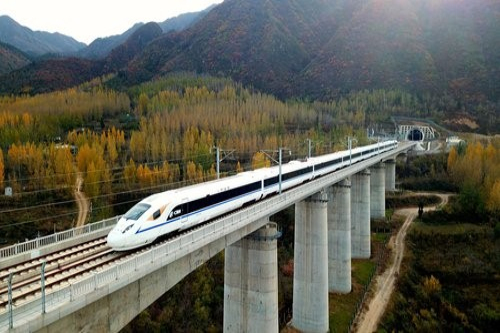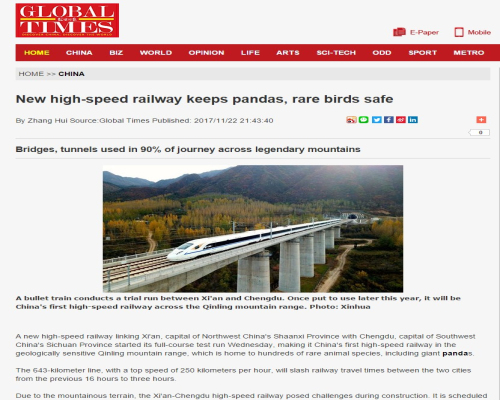头条新闻
海外版报道吴晓民研究团队承担西成专客线
科研项目成果
New high-speed railway keeps pandas, rare birds safe

A bullet train conducts a trial run between Xi'an and Chengdu. Once put to use later this year, it will be China's first high-speed railway across the Qinling mountain range. Photo: Xinhua
A new high-speed railway linking Xi'an, capital of Northwest China's Shaanxi Province with Chengdu, capital of Southwest China's Sichuan Province started its full-course test run Wednesday, making it China's first high-speed railway in the geologically sensitive Qinling mountain range, which is home to hundreds of rare animal species, including giant pandas.
The 643-kilometer line, with a top speed of 250 kilometers per hour, will slash railway travel times between the two cities from the previous 16 hours to three hours.
Due to the mountainous terrain, the Xi'an-Chengdu high-speed railway posed challenges during construction. It is scheduled to become fully operational within the year.
The Qinling mountain range includes precipitous mountains and many rivers and canyons. Since ancient times it has been legendary as extremely difficult to traverse. The area is considered the natural boundary between north and south China.
The railway passes through two national-level natural reserves, one for pandas and the other for the crested ibis. To make way for endangered wild life, animal protection experts were invited to design protective measures during construction and operation.
As of September, there were 345 wild pandas living in the Qinling mountain area. China currently has 1,864 wild pandas.
Long lengths of protective nets for crested ibis were a major breakthrough of the railway, as previous highways and railways in China have not adopted such measures for birds, according to Wu Xiaomin, a research fellow at the Shaanxi Institute of Zoology, who is in charge of the research team for the Xi'an-Chengdu high-speed railway.
Wu's team has monitored the impact of the construction on local animals since 2015, and trained construction workers to better protect animals. The protective measures greatly increased the cost and difficulty of the railway's construction.
The new high-speed railway adopted a number of protective measures for both beasts and birds, the first to do so in China, and has set a fine example for the construction of future railways and highways, Wu said.
"What's more, the innovative technology used in the animal protection measures in the railway could become supporting technology for China to export its high-speed railway technology," he said.
Construction challenges
Zhao Jian, a professor at Beijing Jiaotong University, told the Global Times that the construction of the railway was complex and difficult due to the complicated terrain of Qinling, where a large number of bridges and tunnels had to be built.
About 135 kilometers of the 643-kilometer railway is within the Qinling area.
Bridges and tunnels were used in over 90 percent of the journey across the Qinling, Zhang Hongfeng, an associate fellow of the Shaanxi Institute of Zoology and a member of Wu's team, told the Global Times. Wu's team has been involved in the construction of the railway since 2009.
Trains running on bridges and in tunnels create much less noise, light and vibrations, Zhang added, which also lessens the influence on animals.
The construction of a 13-kilometer-long tunnel took three years, and gas and mud outbursts frequently occurred, Zeng Cheng, a senior engineer at the China Railway Eryuan Engineering Group, the construction company for the railway, told news site scol.com.cn.
In all, the railway took five years to build and involved more than 80,000 construction workers.
The railway employed many new technologies during construction, such as an unstable rock monitoring system in a bid to tackle the complicated terrain and ensure the safety of workers digging tunnels.
